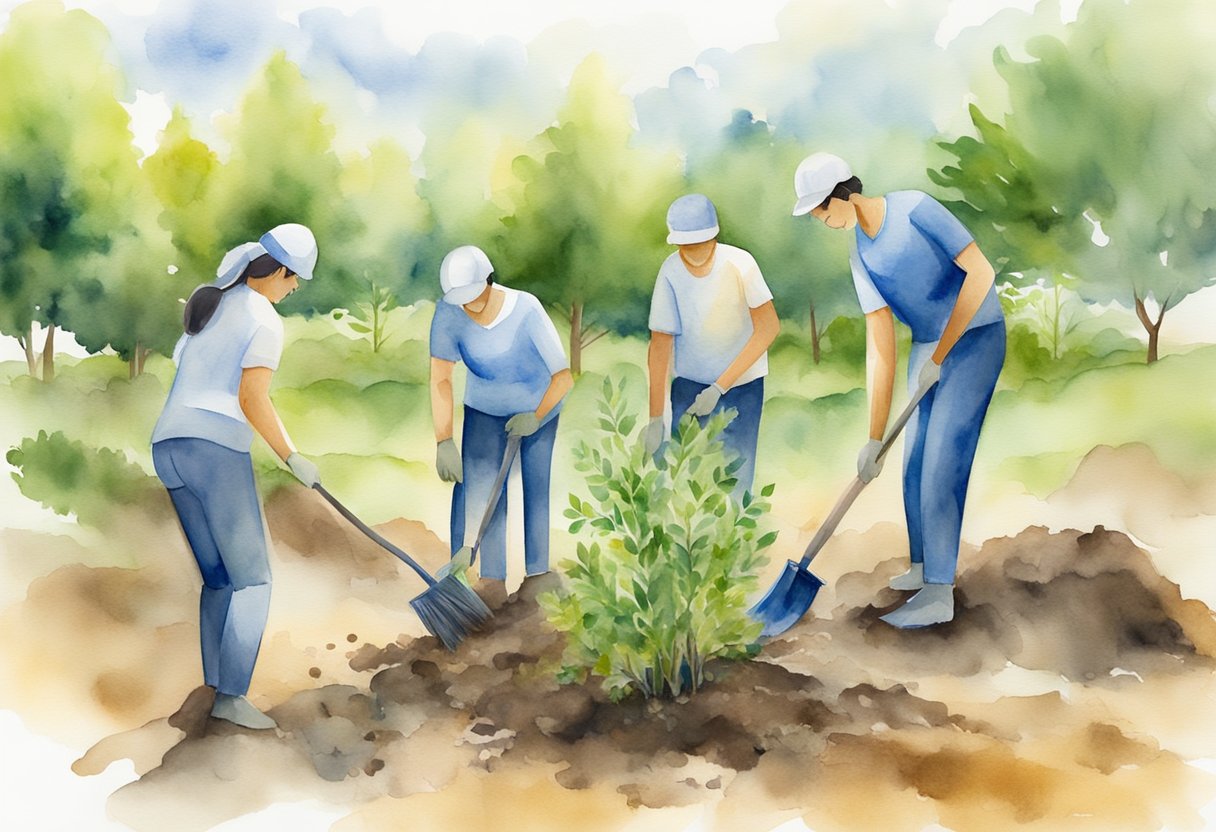Empowering Stories of Resilience

In the intersection between health and environment lies a passionate collective of individuals often termed ‘cancer thrivers.’ Unlike survivors who have passed through the turmoil of cancer, thrivers embody an ongoing zest for impactful change, especially in the realm of environmental advocacy.
Channeling their collective experiences, many find solace and purpose in pursuing a cleaner, safer environment to improve their wellbeing and protect future generations.
She stands out among these thrivers. Having valiantly faced lymphoma cancer twice, her dedication to advocating for environmental health is a beacon of hope and a guide for others. Her work emphasizes reducing the ecological factors contributing to cancer risks, thus fostering a preventative approach to the disease. Her focus extends particularly to men battling cancer, offering them support by promoting sports and physical activity as tools for recovery and empowerment.
Key Takeaways
- Cancer thrivers advance preventative health through environmental advocacy.
- Experience with cancer fortifies the commitment to reducing environmental carcinogens.
- Supporting male cancer patients with empowerment strategies aids in holistic healing.
Understanding Environmental Advocacy
Environmental advocacy emerges as a pivotal force, countering the adverse effects of pollution and galvanizing change for a sustainable future. Drawing from vicissitudes of health battles, advocates like those who have bested lymphoma not once but twice channel their resilience into actions that protect our air, water, and soil, igniting a collective stride towards environmental justice.
The Role of Environmental Protection
They recognize that environmental protection plays a critical role in maintaining healthy ecosystems. It’s a shield safeguarding the air we breathe from harmful pollutants and preserving natural habitats from degradation. Their activism becomes a testament to the interconnection between human health and a thriving environment.
- Preserve habitats: Safeguard biodiversity for balanced ecosystems
- Improve air quality: Reduce carbon emissions to mitigate respiratory issues
Policy and Legislation Impact
Seasoned by their trials, cancer thrivers keenly understand the weight of advocacy in shaping policy. They work to influence legislation that controls pollutants, enforces stricter emission standards, and champions renewable energy. By impacting policy, they strive to engrain environmental protection into the fabric of governance and corporate accountability.
- Enforce standards: Implement stringent regulations for cleaner production methods.
- Champion green energy: Promote policies favoring sustainable energy sources
Sustainability and Climate Change
With a steely resolve, these advocates call for a sustainable shift, understanding that climate change poses a dire threat to global health. Their commitment to sustainability is reflected in efforts to transition societies to low-carbon economies, reducing the greenhouse emissions that fuel global warming and rallying communities around conservation practices.
- Low-carbon economy: Encourage energy efficiency and renewable energy adoption
- Conservation practices: Support community-led climate resilience initiatives
Environmental advocacy, powered by tenacious spirits and guided by hard-earned wisdom, continues to play a key role in fostering a more equitable and livable planet for all, especially for men who have battled cancer, underscoring the vital link between robust environmental policy and the health of generations to come.
Cancer Overview
Understanding cancer involves recognizing its complexity; it’s a disease characterized by abnormal cell growth with the potential to invade or spread to other parts of the body.
Types and Stages of Cancer
Cancer manifests in over 100 types, each classified by the originating cell type. Lung cancer and leukemia are among the frequently diagnosed types, each with unique characteristics and challenges. Cancers are further categorized by stages I through IV, indicating the size and spread of the malignancy. Stage I denotes a localized tumor, while Stage IV cancer signifies distant spread.
Research and Oncology
Oncology, the study of cancer, drives the quest for advancements in diagnosis and treatment. Research centers blend rigorous science with compassionate care to develop safer therapies tailored to individual genetic profiles. This scientific endeavor extends lives and enriches the quality of life for those battling cancer, aligning to transform patients into survivors.
Cancer Risk Factors
The incidence rate of cancer is influenced by a spectrum of risk factors, including genetics and lifestyle choices. Tobacco use, poor nutrition, and specific environmental exposures significantly heighten the likelihood of developing cancer, especially among men. Cancer prevention strategies and education target these modifiable risks, offering a proactive approach to reducing the global cancer burden.
Environmental Exposure and Cancer
Cancer thrivers often become fierce advocates for reducing environmental risks. Their unique experiences galvanize communities to promote ecological health and safeguard against malignancies.
Air and Water Pollutants
Air pollution plays a significant role in environmental exposure that can lead to cancer. It’s understood that airborne contaminants, from factory emissions to vehicle exhaust, add to the burden of lung and other cancers. Air toxics such as benzene and arsenic are pervasive in industrial areas, demanding rigorous oversight for cleaner air. In parallel, water sources laced with industrial waste or agricultural runoff containing pesticides threaten public health. These water pollutants necessitate strict regulation to prevent contamination and protect communities.
Chemical Exposure and Public Health
Exposure to hazardous chemicals often occurs through occupational hazards or household products. For instance, individuals in specific jobs may encounter asbestos, a known carcinogen associated with mesothelioma. Similarly, relentless efforts to educate on household chemicals and their potential dangers aim to reduce the incidence of cancers. Our understanding evolves as research sheds light on the link between various chemicals and cancer, supporting policies to curb such chemical exposure and amplify environmental health.
Radiation and Carcinogens
Radiation stands out as another environmental risk for cancer, with radioactive elements like radon lurking in homes and naturally occurring in certain regions. Vigilant testing and mitigation measures can significantly reduce radon exposure, demonstrating proactive approaches to reduce cancer risks. The careful management of medical and industrial radiation sources also plays a crucial role in preventing unnecessary exposure to potential carcinogens. These actions reflect a society committed to the welfare of individuals, especially those who have tackled cancer and advocate for a healthier environment for all.
Preventing Cancer in a Changing Environment
As the world grapples with environmental changes, the focus on cancer prevention becomes more pertinent. From daily choices to systemic efforts, this section explores practices men can adopt to reduce cancer risk.
Lifestyle and Diet Choices
Men can mitigate cancer risk by emphasizing nutritious, whole foods and maintaining a healthy weight. Diets rich in vegetables, fruits, and fiber bolster defenses against cancers typically influenced by lifestyle factors. The American Cancer Society suggests choosing foods and beverages in amounts that help achieve and maintain a healthy weight. Regular physical activity, another critical facet, helps reduce the risk of obesity, a known cancer risk factor.
Early Detection and Screening
Screening programs play a crucial role in reducing cancer mortality rates among men by detecting cancers at an early and more treatable stage. Embracing technologies that pinpoint environmental carcinogens can inform personalized screening schedules. Committing to regular check-ups and understanding the value of early detection can lead to prompt interventions and better outcomes.
Healthcare and Community Support
A robust healthcare system that incorporates a focus on environmental causes of cancer offers more robust community support for survivors. Healthcare professionals guide patients through recovery and into survivorship. They also help survivors channel experience into environmental activism, which paves the way for a healthier future for all generations.
Patient Empowerment and Advocacy
Patient empowerment transforms individuals dealing with cancer into advocates for their care and wellbeing. This dynamic process enables them to participate in decision-making actively and fosters a community-driven approach to healthcare.
Cancer Thrivership
Cancer thrivership begins with a mindset that turns patients into active participants. These individuals do not just survive; they thrive despite their diagnoses. Resources like the Alliance of Nurses for Healthy Environments equip patients with the knowledge to make informed choices, including those that pertain to environmental factors linked to health.
The Power of Patient Communities
Patient communities offer a collective strength that is indispensable for cancer care. Here, men battling cancer find solace and strategies for overcoming their unique hurdles. Strength in numbers also translates to powerful advocacy for quality care and policies prioritizing patient health in all communities, including historically marginalized groups.
Navigating the Health System
Navigating the health system is a key component of patient advocacy. Caregivers, alongside organizations like Health Care Without Harm, support patients in understanding the intricate healthcare landscape. They ensure patients receive quality care tailored to their needs while promoting sustainable healthcare practices.
Challenges and Opportunities in Cancer Treatment

Navigating the intricacies of cancer treatment presents a unique set of struggles and prospects. The evolution of medical care, alongside the significant economic weight it imposes, informs a need for partnership in oncology.
Innovations in Medical Treatment
Medical treatment has advanced with the introduction of personalized therapies aimed at targeting cancer more effectively. These include precision medicine and immunotherapy, which tailor treatments to individual genetic profiles and stimulate the body’s immune response, respectively. In hospitals, such innovations have improved cancer patients’ survival rates and quality of life.
The Economic Burden of Cancer
Cancer not only impacts health but also imposes a heavy financial burden on patients, families, and the healthcare system. The costs associated with cancer treatments, from initial diagnosis to end-of-life care, can lead to financial toxicity, rendering the treatments themselves as challenging as the cancer burden. It is imperative that the economic impact is considered in treatment plans.
Collaborative Approaches to Care
Through collaborative approaches, care for cancer thrivers has taken on a holistic dimension. Integrated teams across multiple disciplines combine to provide comprehensive oncology care, merging medical care with psychological and social support. Healthcare systems increasingly value multidisciplinary care paths to optimize patient outcomes.
Environmental Advocacy Moving Forward

Environmental advocacy stands at a pivotal crossroads, with the actions taken today shaping the health and sustainability of tomorrow. Efforts to mitigate the ecological consequences of human activity are more urgent than ever as global temperatures rise and non-communicable diseases proliferate.
Future Outlook and Predictions
President Biden’s administration in the United States has set ambitious emissions standards to pivot away from fossil fuels and align with Sustainable Development Goals. Such regulatory strides suggest a trajectory towards cleaner energy in compliance with sustainability benchmarks. Projections indicate a positive shift if these sustainable development strategies are implemented with conviction and widespread support.
Mobilizing Efforts for Healthier Environments
They energize communities to champion healthier living spaces to defend against non-communicable diseases, which often correlate with environmental factors. Advocacy drives towards rigorous emissions standards and curbing fossil fuel reliance is instrumental in this journey. They catalyze change by voicing concerns and spearheading local initiatives that underscore the value of environmental health as a cornerstone of community wellbeing.
International Perspectives and Action
Globally, efforts converge as nations commit to reeling in global temperatures and fostering sustainable development. The dialogue, forge international alliances and reinforce compliance with environmental treaties. The universal adoption of Sustainable Development Goals paves the way for a unified front against the adversities posed by climate change — setting a precedent for collective responsibility on an international scale.
Final Thoughts…

The journey through lymphoma, not once but twice, forges a path of resilience and empathy. It’s a transformation that goes beyond the individual, reaching into the broader context of environmental health.
Cancer thrivers, particularly men who often seek strength through stoicism, can find a powerful ally in environmental advocacy. Lymphoma teaches the fragility of health and the imperative to nurture the world in which we live.
Environmental issues are increasingly connected to the wellbeing of communities. The push for cleaner air and less pollution directly benefits those in remission and those facing health challenges. The efforts of organizations striving for a sustainable approach to cancer care demonstrate the precise relationship between a thriving natural world and human health.
Men who channel their experiences into environmental efforts showcase an exemplary model of care and survival. It’s an act of giving that echoes further than one might imagine. They set an example, proving that action toward environmental health is a testament to their strength and resilience.
Thrive through action, and let each step forward be a planting of hope for healthier, more vibrant communities. The legacy of a cancer thriver becomes not just about the battles won within but the broader impact made for others. They become the catalysts for change, carrying a message of survival and the importance of preserving the world for those who follow. -T
Frequently Asked Questions
This section addresses key inquiries surrounding Cancer Alley and the role of environmental justice, touching upon the resilience of cancer thrivers in the fight against recurring disease.
What are the primary factors contributing to the establishment of Cancer Alley?
Cancer Alley emerged due to a dense concentration of petrochemical plants along the Mississippi River between Baton Rouge and New Orleans. These factories release pollutants known to carry cancer risks, creating a hotspot for health and environmental concerns.
How does environmental justice play a role in the Cancer Alley situation?
Environmental justice highlights the need to address the disproportionate impact industrial pollution has on low-income and minority communities in Cancer Alley. Advocates for this movement demand equitable distribution of environmental risks and benefits.
Which parishes are considered a part of Cancer Alley and why?
Parishes such as St. James, St. John the Baptist, and Ascension are part of Cancer Alley. They are identified by their high concentration of chemical industries and elevated reports of cancer rates compared to other regions.
What measures are companies in Cancer Alley taking to address environmental concerns?
Companies are implementing pollution control technology and adhering to regulatory standards—some partner with local communities to monitor air and water quality to reduce their environmental footprint. But there is room for improvement.
What is the significance of being a cancer thriver, and what does this term imply?
A cancer thriver is someone who lives with cancer as a chronic condition and strives for a fulfilling life despite the disease. This term reflects determination and a proactive approach to managing health challenges.
In the context of cancer recurrence, what percentage of cancer thrivers face this challenge?
While specific percentages vary by cancer type and patient demographics, a significant number of cancer thrivers may confront recurrence, necessitating continuous vigilance and medical support in their journey.
